| B18C Compression Test |
|
Anytime you build a performance motor and for some unknown reason, it isn't running right or is blowing smoke out of the tailpipe, then something is obviously wrong that needs immediate attention. The first step to tracking down your problem, would most likely be a compression test and a leak down test to determine the source of the problem.
A compression test will tell if you are low on compression in any of your cylinders. There are many potential problems that can cause low compression. For example, you could have a bent valve, or bad compression rings. You could have a hole in your piston or broken ring lands. All of which should require immediate attention before further damage is incurred.
A stock B18C should have a compression test result of around 200psi. Combined, the cylinders should not vary more than +/- 20psi. In this test, we will compare a high compression NA motor with 11.6:1cr against a low compression turbo motor at 9:1cr.
The following tools are required to perform a compression test:
. Spark plug socket and rachet
. Compression tester
How to do a leakdown test
|
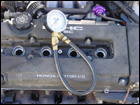 |
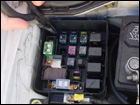 |
The first step is to remove the spark plug cover and plug wires. Then make sure that you remove the 15A fuse in the fuse box that control the FI injection. That way when you crank the motor over no fuel will be squirted into the cylinders. |
 |
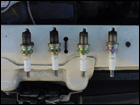 |
Once you've removed the spark plugs, its a good time to inspect them for discoloration or damage. They should be a brownish red color and the electrodes should be fresh and not worn down. If the plugs are white in color then you are running lean. If they are black, then you are running rich. |
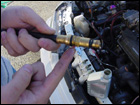 |
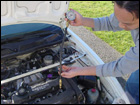 |
Now before using the compression tester, make sure the o-rings are in good condition and slightly oil them up so that they don't get damaged. Then carefully insert it into the first cylinder where the spark plug normally goes and hand tighten by turning the hose on the compression tester. You are now ready to crank the motor over. Have someone hold the compression tester while you press the gas pedal all the way to the floor, this is very important. While the pedal is pressed down, turn the ignition on and crank the motor over 5 times. |
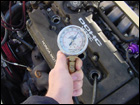 |
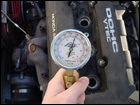 |
You should now have a reading on the compression tester. If you think you've messed it up, reset the compression tester by pressing the nipple under the gauge face and repeat the cranking procedure. Repeat these steps one at a time for all four cylinders. Make sure that all the spark plugs are removed during the entire process. You can see that on our first test vehicle with the low compression motor, we yielded 175psi-185psi across the board. The motor is very healthly. |
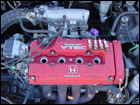 |
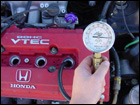 |
Now we compare the compression on our 11.6:1cr motor. #1 cylinder has a wopping 250psi! |
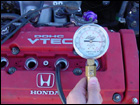 |
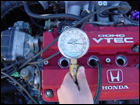 |
#2 cylinder also has an amazing 250psi compression. Looks like #3 is hitting 255psi! |
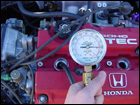 |
And finally 250psi on #4. Once you are complete, remove the compression tester and replace the spark plugs, plug wires, cover and fuse back to their original condition and be sure to repace any bad plugs that you found. If your compression is low, or any of the cylinders were beyond +/- 20psi of the others, then make sure you have the motor checked out immediately by a qualified service technician. |
|